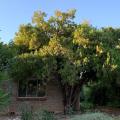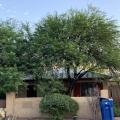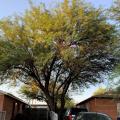Scope
Design and install landscaping to reduce heat gain to the home:
- Create a site map showing existing vegetation and the location of the future or existing buildings.
- Create a landscape design to strategically maximize shading and evaporative effects, minimize heat gains from hardscaping, and maintain solar access for the wintertime.
- Grade for drainage around the house and for water retention on the grounds.
- Plant or preserve landscaping around the home to strategically shade walls, windows, roof, skylights, hardscaping, and pavement.
- Install architectural structures such as pergolas and trellises to enable strategic plantings.
- Incorporate water features as appropriate.
- Install light-colored and permeable hardscaping and pavement.
See the Compliance tab for links to related codes and standards and voluntary federal energy-efficiency program requirements.
Description
With a warmer global climate, addressing cooling will become increasingly important. Impacts of cooling measures are greatest during extreme heat events. Well-planned landscaping can keep a home and grounds significantly cooler than a home without good landscaping (Figure 1). Landscaping can reduce air-conditioning loads, reduce the urban heat island effect, and help both air-conditioned and non-air-conditioned homes ride out an extreme heat event. On top of these benefits, landscaping requires no electricity (works during power outage), looks good, increases home value, and unlike many other heat-reducing technologies, can let heat in during the winter.
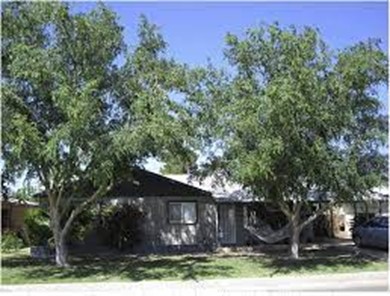
Before air-conditioning, large shade trees were a priority to those living in hot climates. The value of trees in these (and other) areas is real: trees have been shown to increase value when selling a home. Landscaping can be an effective tool to reduce local temperatures and increase survivability during an extreme heat event. It can reduce indoor temperatures and can also create a comfortable outdoor space on a hot sunny day. As shown in Figure 2 below, a single large canopy tree can grow to provide shade to windows, walls and driveways, keeping the home and local environment cool. In the image, the temperature of the grass under the tree is about 10°F cooler than the unshaded grass. Much greater temperature reductions are possible on hardscaped surfaces or pavement. If a home lacks air conditioning, or the A/C is not working, or power is out, a shady yard may be a great refuge.

Neighborhood-level comfort can be affected by landscaping as well. Heavily landscaped/shaded neighborhoods have been shown to be at least 1 to 5 degrees cooler overall during hot summer afternoons than less shaded locations (Sonne and Viera 2000, Vuckovic et al. 2017).
Studies show that shading from landscaping can greatly reduce cooling needs and electricity consumption for air-conditioning. Measured potential annual cooling energy savings from landscape shading average between 10 and 50% (Meier 1990, Pandit and Laband 2010).
Some studies show even greater impact during high-heat conditions. Two identical houses tested in Alabama revealed a 59% reduction in measured July cooling for the home in full shade versus the home in full sun (Laband and Sophocleus 2009). A study conducted on two houses in Sacramento demonstrated 30% cooling energy savings just by relocating large trees (Akbari et al. 1997). Locating plants around the A/C condenser to provide shading without inhibiting air flow was shown to reduce cooling by about 2% in a Florida study (Parker et al. 1996).
Plants and trees provide cooling through both shading and transpiration. Transpiration is the process by which water from the ground flows up to the leaves of a plant, where it evaporates into the surrounding air. This evaporation reduces the local air temperature through the evaporative cooling effect. A large tree can transpire up to 100 gallons of water per day if the ground moisture and air conditions are sufficient (Gkatsopoulos 2017).
Evaporation from soils, mulches, and water-permeable surfaces also contributes to local cooling. This evaporation, combined with transpiration, is called evapotranspiration. Materials that can absorb, store, and re-release moisture will contribute to cooling through evapotranspiration, while hard surfaces such as asphalt and concrete will not. These hard, impermeable surfaces tend to block or limit the absorption of water when it is raining and will slow the evaporation of ground moisture when it is hot outside.
When utilizing landscape vegetation to shade a house, orientation is of high importance. See Figure 3. In the middle of summer, the east and west walls and windows of a home will receive the most solar heat. In early and late summer, the south side of a home will receive approximately equal solar load to the east and west. In spring, fall, and through the winter, the south side of the home will begin to receive the greatest amount of solar energy (NREL 1995). For these reasons, shading should focus first on the east and west walls and windows, and next on the south walls and windows.
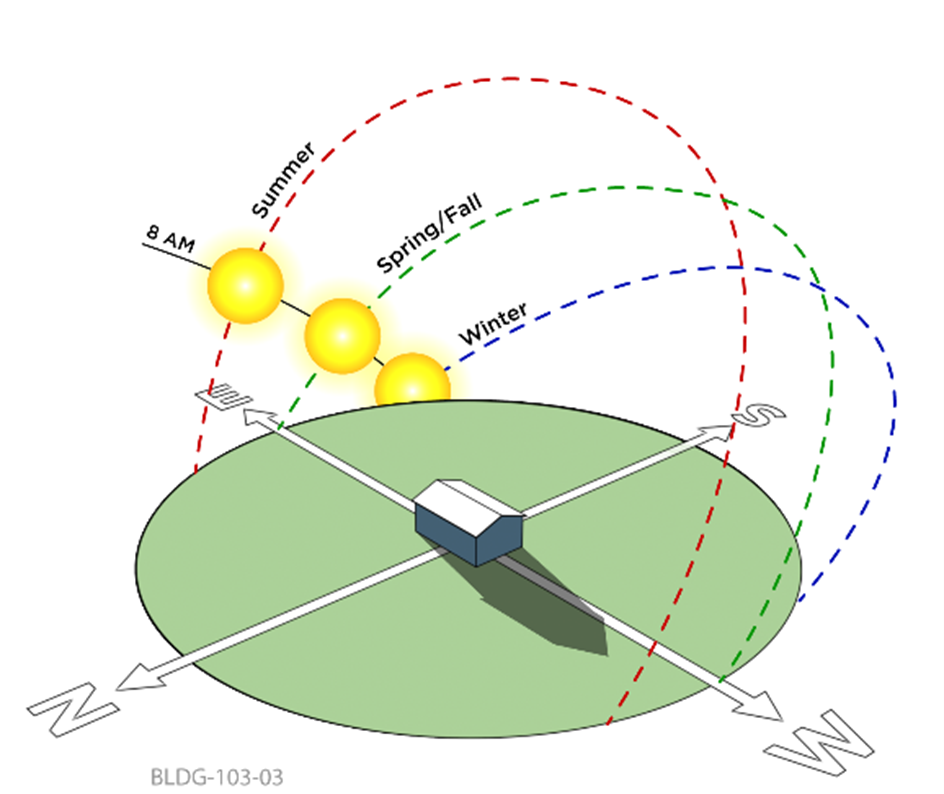
Roofs and pavement can reach temperatures 50°F to 90°F higher than the air temperature if they are in the sun instead of the shade (EPA 2008). These surfaces give off heat to the surroundings, including nearby homes. Shading hardscapes such as driveways, patios and adjacent road pavements, even though not part of the home, may still reduce energy bills.
Paved areas having lighter-colored surfaces will absorb less sunlight and will stay cooler than dark paved surfaces. Dark asphalt in a sunny area will increase surrounding temperatures. Specifying lighter (high albedo) material for paved areas will reduce this effect. The most environmentally friendly option is simply to reduce pavement areas as much as possible. Shading as much of the paved area as possible is also effective. The EPA has produced guidance on reducing the warming effects of paved surfaces in the Cool Pavements chapter of their Heat Island Compendium.
Planting rows of shrubs and trees or trellises can reduce the infiltration of hot air by reducing wind flow near the building. This may be helpful when attempting to keep the building sealed up during wildfire events with heavy smoke, although the trees may also be a liability if fire is approaching. This wind-blocking effect is more significant in the winter than the summer, so priority should generally be given to blocking cold winter winds. Using evergreens on the north side of the house is an effective way to reduce winter infiltration without blocking winter sun.
See the Passive and Low-Energy Cooling guide for additional considerations on how landscaping and water features can enhance cooling via shade, evaporation, and wind.
Preserving Trees
When building a home on a site with trees, there are a number of factors one should consider to make sure they survive. A local arborist should be consulted. Some of the practices generally recommended are provided below.
- Conduct a tree inventory and determine the health of the trees to be preserved (Figure 4).
- Protect the tree roots all the way out to where the canopy ends (Figure 5). Tree roots will typically extend as far as the canopy.
- Put temporary barriers around the tree out to the canopy to avoid compaction from equipment. This should be done before clearing the trees you want to remove so as to avoid confusion of which ribbon color means keep or remove.
- Do not alter the soil depth around the tree- this may require creating tree wells if filling the site with soil (Figure 6).
- Do not use this area for trash during construction as some chemicals from paints, stains, or other products may hurt the roots over time.
- If building in a hurricane-prone area, consider how high winds will affect the trees you choose to preserve.
- If thinning from a forested site, only the trees on the edge may have been exposed to heavy winds and will have the extra resistance to avoid damage –check with a local arborist before selecting which trees to keep or remove.
- Some species are fairly resistant to storms, such as live oaks and many palm species. Palms shed their fronds, and their leaves fold in during high winds which minimizes their “sail.”


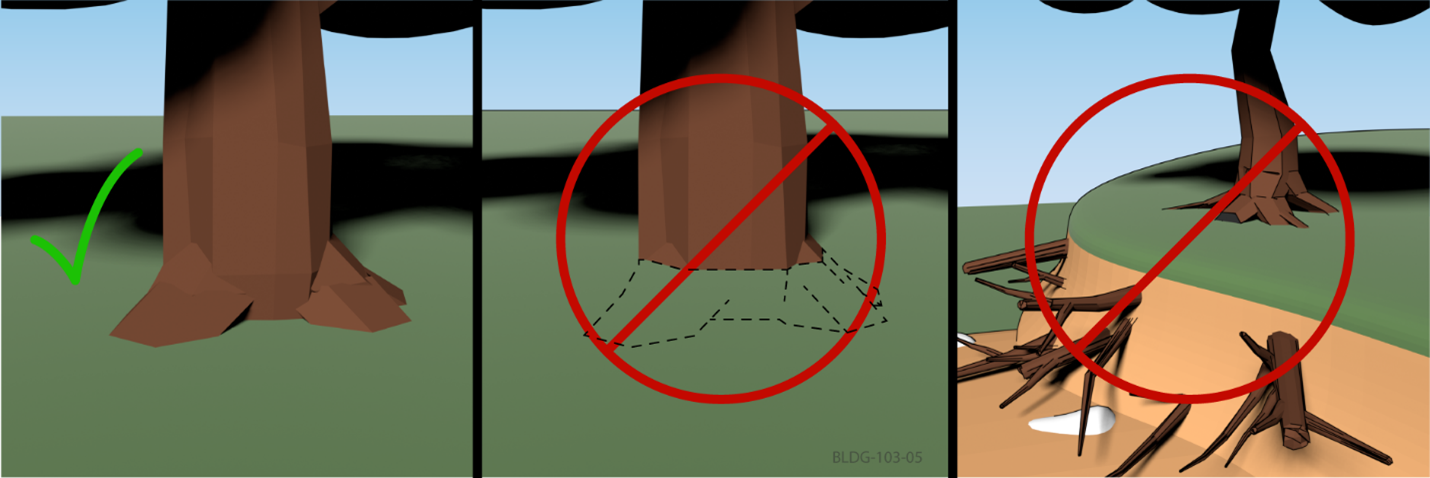
Figure 6. Leave the soil level around an existing trunk as is (left); do not increase soil height (center) or remove soil in the root zone (right) (Source: FSEC, based on PennState Extension 2022).
Installing New Landscape Plants
A local landscape architect and local nursery professional should be consulted in any landscape design. The slogan to remember for new plants is “right plant, right place.” Is the plant correct for the climate, soil, and drainage? Often native plants fit this description. Consider how big the plant will be when mature, what part of the house it will shade, whether it can survive on precipitation or if it will need irrigation, and whether it is naturally resistant to pests or if it will need pest control. When mature, will the plant shade somebody else’s solar access, will it interfere with utility lines, will it uproot sidewalks, or will branches interfere with pedestrian or vehicle traffic? Some states have university extension services, water boards, and/or arborist and nursery associations, including native plant nursery associations that may provide material helpful in making smart choices.
When planting, make sure that the roots of plants go beneath the soil line and the trunk all remains above the soil line. Support young trees with stakes. Do not mulch up to the trunk as the root “collar” needs air circulation (see Figure 7).
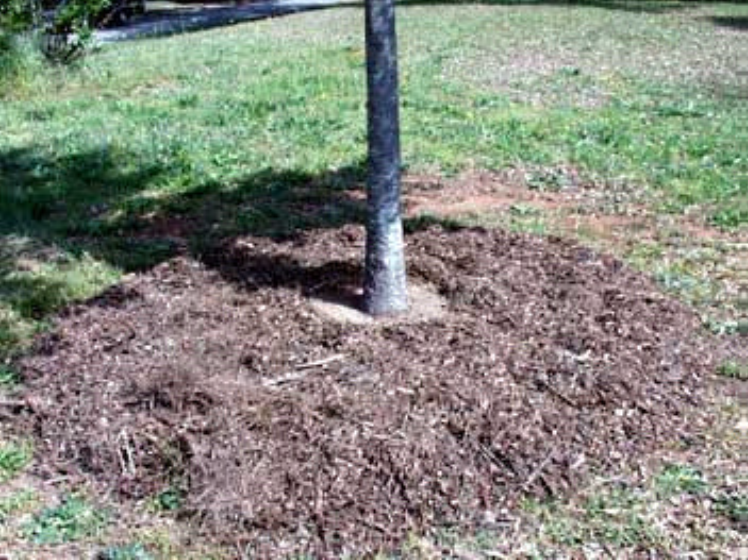
Local Jurisdiction Requirements
Cities and counties may have landscape or tree ordinances. These ordinances may require permits to remove trees or perhaps some native plants that are seen as benefiting the community. On the other hand, local ordinances may require removal of invasive non-native plants. Local or state ordinances may give the right for each property owner to solar access, so planting a tree where you may block a neighbor’s access for solar collectors or passive solar heating could be a violation. In such a case, the tree may have to be cut down after it grows a few years. Local ordinances may also determine setbacks from streets, sidewalks, utility lines, sewer lines, water lines, and gas lines. They may also have a list of allowable tree or plant species.
Learn about local ordinances that may indicate which tree species you can plant, if any, between the sidewalk and street. Figure 8 shows live oak trees that are doing quadruple cooling duty in an Orlando, Florida, neighborhood. First, the oaks are shading the townhomes. Second, they are shading the sidewalk. Third, they are shading parked cars, reducing the need for extra vehicle air conditioner use. And fourth, they are shading the roadway, helping keep neighborhood temperatures cooler. Street shade trees require maintenance. When young, these trees had branches cut regularly to avoid hitting pedestrians and vehicles. Depending on soil and species, street tree roots may cause uplift of sidewalks or road surfaces, although no such problems are visible here. The neighborhood has underground utilities so the tree canopy is not interfering with overhead utility wires.
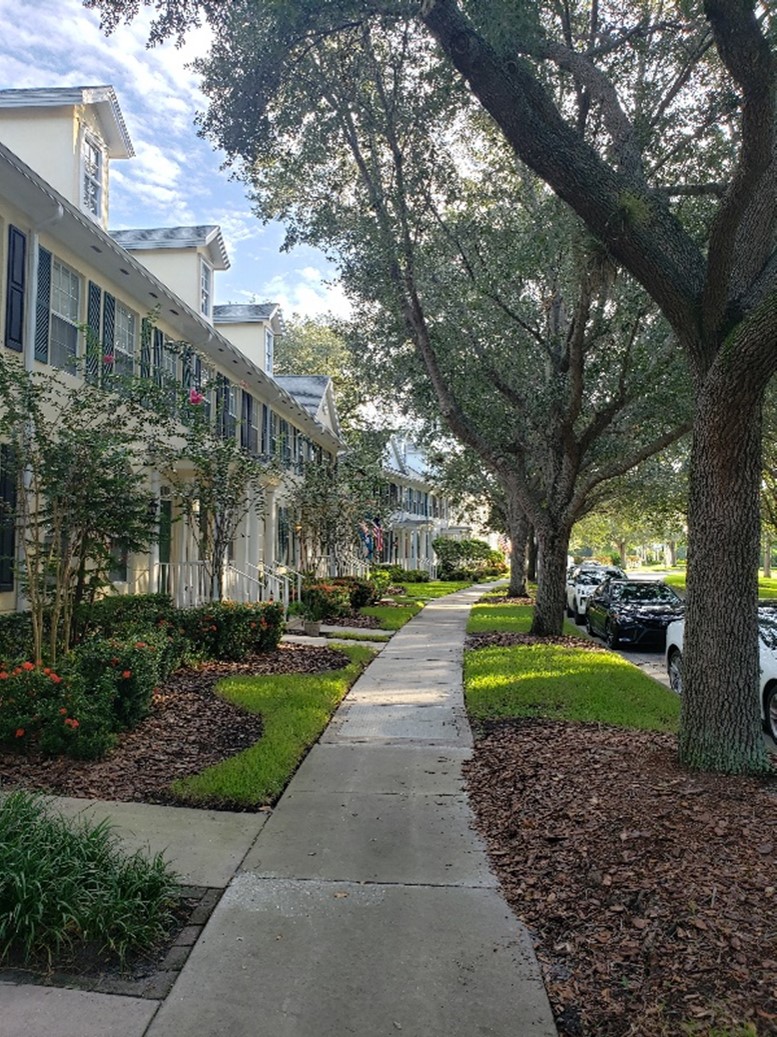
How to Use Landscaping to Reduce Cooling Load on a Home
There are many ways that landscaping can be used to reduce the cooling load on a house (see Figure 9).
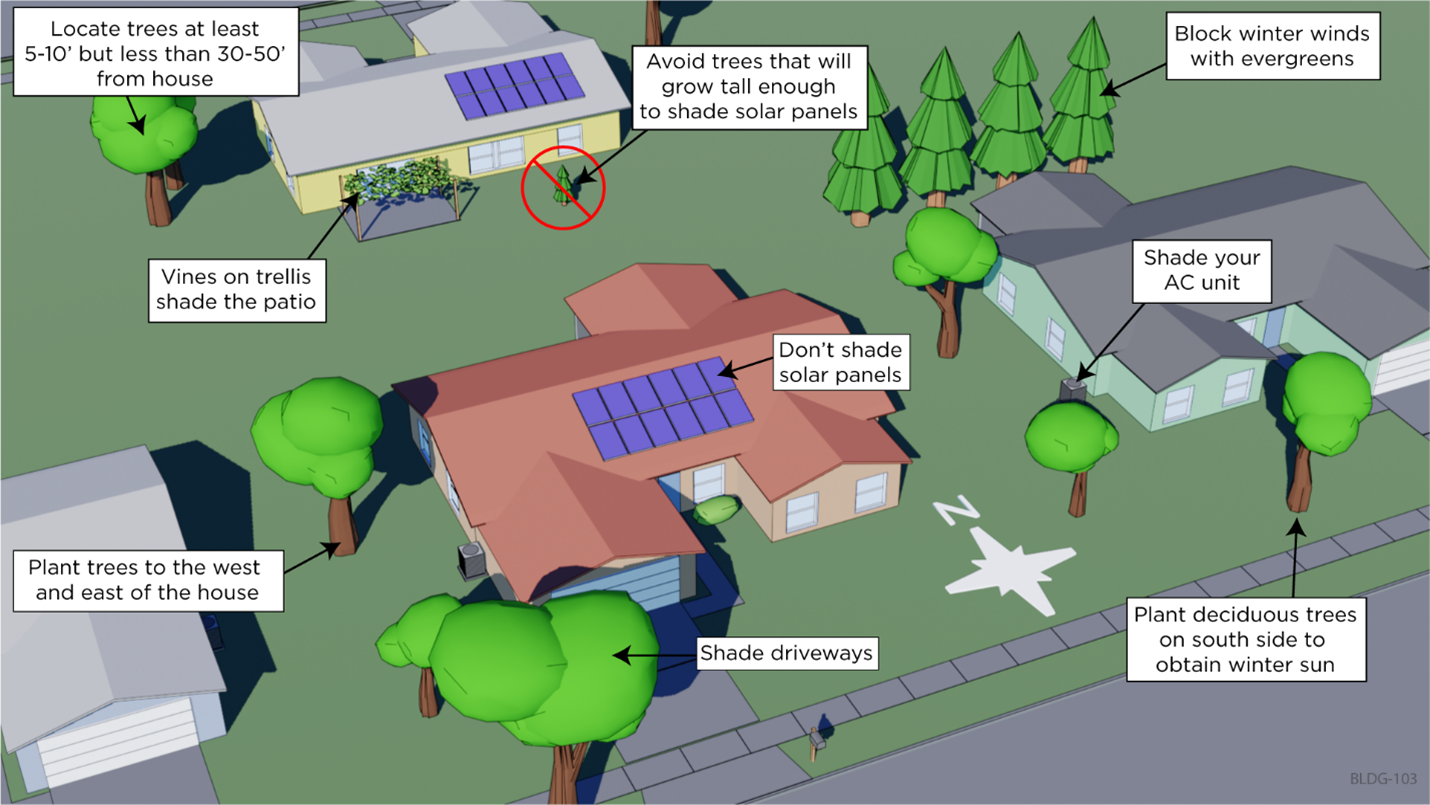
- In the summer, the sun hits the east and west sides of a home most directly, followed by the south exposure. For shading, eastern and western exposures should receive greatest emphasis. Southern exposures should receive the next greatest emphasis, and northern exposures are least important.
- Windows and skylights are the highest priority for shading, followed by roofs and walls. Shading roofs and skylights with landscaping may not be practical in many instances. Shading windows will have a much greater cooling effect than simply shading walls (See Shading and Solar Control for Windows and Skylights).
- Plant bushes, shrubs, and trees in strategic locations to shade the home as well as any hardscaping or pavement.
- For immediate impact, strategically place large container-grown plants to shade windows and critical exposures.
- Consider installing vertical trellises and planting vines to shade walls and windows. Vertical trellises are particularly good at blocking the low, direct sun that comes from the east and west. See Figures 10 and 11.
- Tall, fast growing, leafy annuals like sunflowers can grow quickly to provide aesthetic summer shade to 1st story windows and walls without having to commit to larger/heavier landscaping. Annuals also die back in winter, allowing full access to solar heat when it is cold outside. See Figure 12.
- Horizontal pergolas, with vines growing on them, are an effective approach to shading patios, walls, and windows.
- Window boxes with upright plantings can provide partial summertime shading to windows. This strategy may not shade an entire window, but even a small amount of shading is helpful when other options are not available. Additionally, the window box itself will at least shade a portion of the wall, as will any plants that hang down from the planter. Further, the plantings will provide the cooling effect of evapotranspiration, and the plants can be removed in winter to allow full solar access.
- Consider native and drought tolerant ground covers to reduce maintenance and irrigation while increasing longevity.
- Opt for trees that have a large canopy to cool both the house and the surrounding grounds.
- Select deciduous species of trees in any location where solar access for heat, light, or views in the winter are a priority.
- Make appropriate trade-offs between shade for summer cooling and allowing solar heat gain in the wintertime. If the heating season in your climate is short or mild, using deciduous trees on the south side, and deciduous trees or evergreens on the east and west may be best. If your heating season is moderate, consider deciduous or no trees on the south side, and deciduous trees on the east and west. If you are in a region with a long heating season, then you may want to have no trees on the south side, and deciduous trees on the east and west sides (for more information on using the sun for winter heat, see the Passive Solar Home Design page by DOE’s Energy Saver program).
- Do not locate trees where they will shade new or future solar electric PV systems.
- Ensure tree roots will not cause issues with building foundations or underground piping.
- Plant trees far enough away from the house to avoid damage from roots or falling limbs, but close enough to provide effective shade. Recommended distances from the house depend on canopy height and orientation and may be 7 feet for a small tree that will only grow to 15 ft tall, to 20 or more feet away from the house for trees that grow to 40 ft tall or more.
- Be careful to maintain appropriate distances between vegetation and the home in areas with wildfire danger.
- Avoid species of plants that are invasive in your area. Seek advice from extension services as nurseries and national retailers sometimes carry invasive species.
- If shading the outdoor AC condenser, be careful not to interrupt upward airflow pattern.
- If possible, consider using gullies, swales, or other features to retain water on site. This promotes absorption of water into the soil, allowing evaporative cooling when it is hot outside. Rainwater retention also reduces water runoff that can pollute water bodies with pesticides, fertilizers, and other pollutants.
- If using on-site retention, make sure that overflow will drain away from your house and other houses. This is often easier for a developer to do with an entire development than a builder to do on a small residential lot. However, on some large residential lots this strategy may be employed.
- Strategically place water features where the evaporative cooling effect will have the most impact. If possible, locate the retention or other water feature where prevailing summertime winds will be cooled by the water on the way to the house.
- Retain rainwater on-site in a cistern for irrigation or for water features. Abide by local codes and health guidelines when using this untreated water.
- Water fountains or small pools can also serve as air cooling features. However, they require pump energy, maintenance, and makeup water. The cooling benefit may be outweighed by the unnecessary water and energy consumption.
- In arid areas water is generally a precious resource and using water features that may be evaporating water all summer or all year is not typically an environmental or resource-friendly solution. Allowing natural rainwater to absorb and re-evaporate, and using vegetation for shading, are much more sustainable approaches.
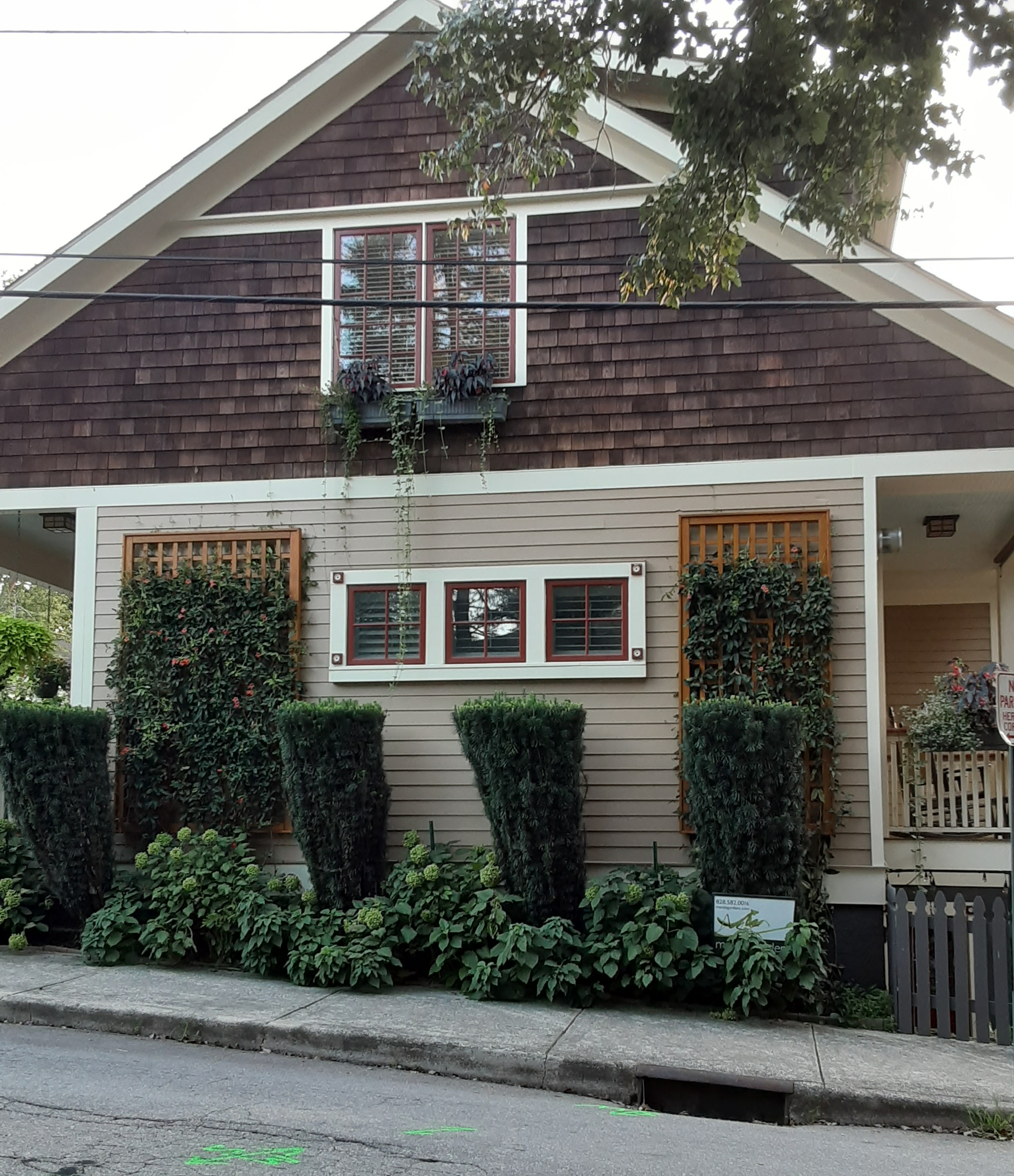
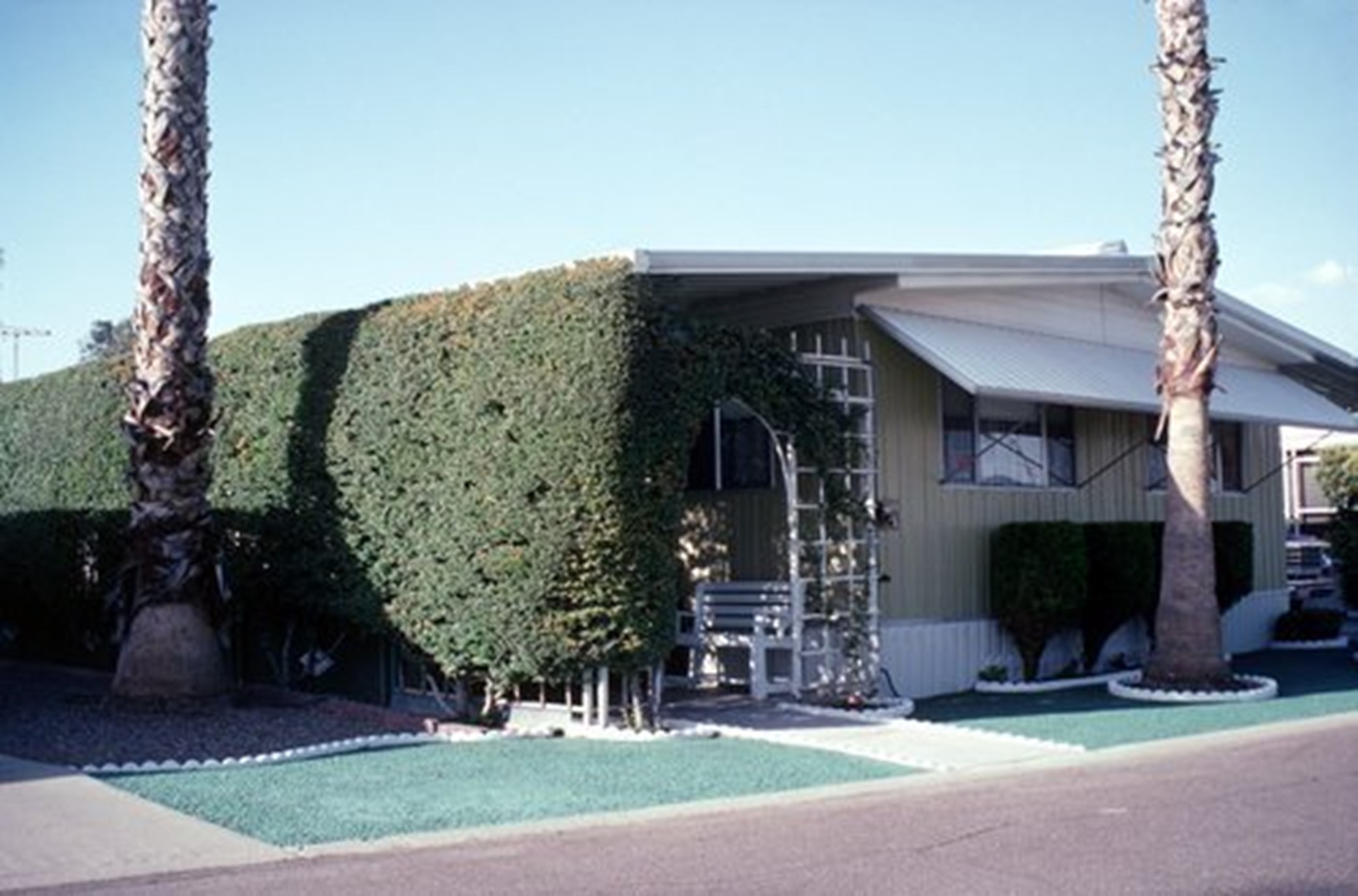
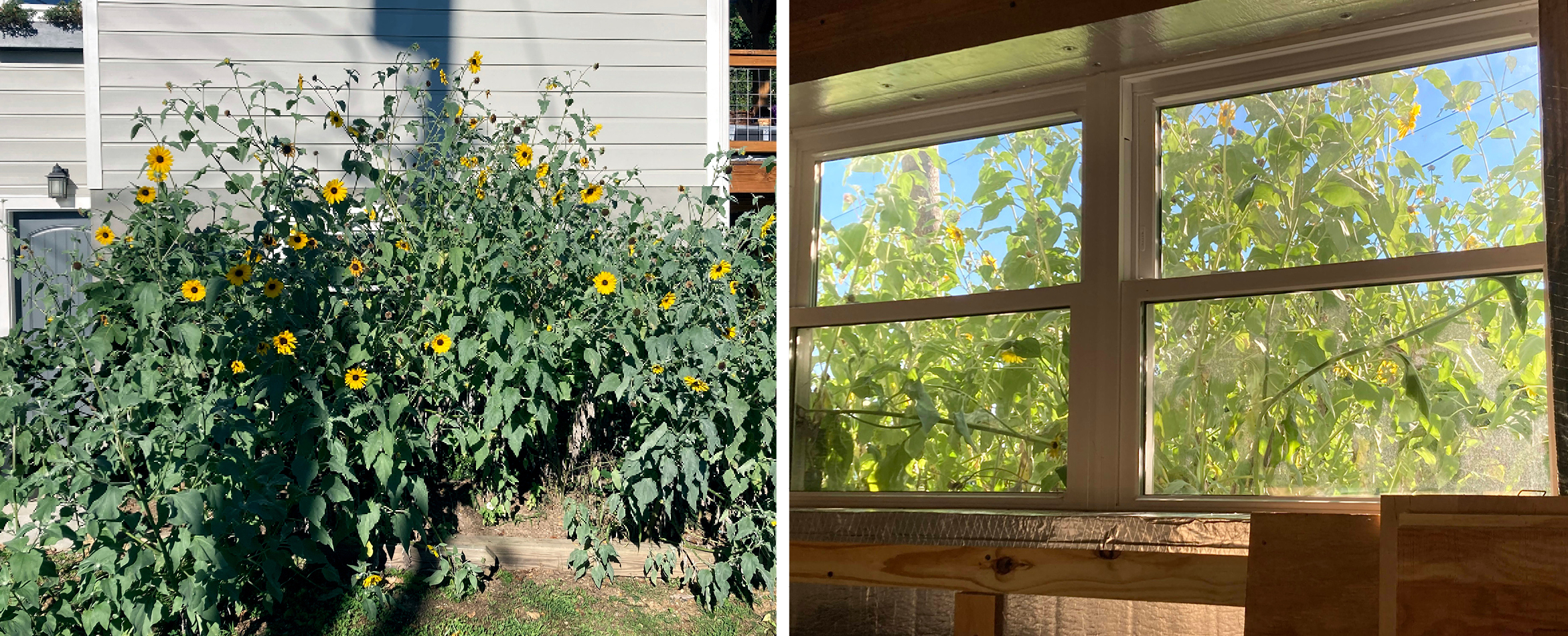
Success
The benefits of landscaping will only apply if the landscaping survives. This requires appropriate selection of what is to be preserved and planted.
Ideally, a contractor will have one or more well-trained landscapers among their team members. There are at least two different levels of expertise, one for preserving trees (usually an arborist) and one for selecting plants and developing a landscape plan (usually a landscape architect and/or a local nursery person).
Training courses can be found at various state extension service sites. Some local colleges may also provide low-cost continuing education classes. Training on plants is best done locally as soil and climate are major considerations with the success of plants.
The Extension Foundation, Cooperative Extension, and the U.S. Department of Agriculture maintain a free online course titled “Trees for Energy Conservation.” This course covers topics such as tree growth and development, soils, arboriculture, assessing tree risk, tree disorders, construction practices related to trees, public policy, and urban forest management.
For new construction projects, the local government may require planting a certain number of trees. Additionally, local homeowner associations often enact rules regarding landscaping. Some of these may contradict the homeowner’s desire to shade the home or to have solar access. Consider proximity to neighbors as overhanging of branches, root growth, etc. can result in conflicts and potential legal action. Codes in wildfire-prone areas may influence allowable landscaping decisions and proximity to the house. For all of these reasons, it is paramount to understand the regulations prior to clearing land or designing the landscape.
Landscaping in State, Regional and national home labeling programs
There are several local, state, and national home rating programs that promote water-conscious and region-appropriate landscaping. Planting low-water-consuming plants can help builders earn a WaterSense designation from the U.S. Environmental Protection Agency or a low (good) HERS H20 index from the Residential Energy Services Network (RESNET). One state example is the Florida-Friendly Landscaping™ (FFL) Program, which encourages minimal use of potable water for irrigation, avoiding the runoff of excess fertilizers and pesticides from the landscape, and providing habitats for wildlife. Learn about the compliance requirements of these programs prior to creating the landscape plan.
For existing residences, some localities or utilities may have programs for tree rebates or groups that will help with tree planting, reducing the up-front cost.
Landscaping and increased sales value
Studies showing side-by-side comparisons of new homes with and without trees have indicated faster sales for locations where trees were preserved. A mathematical model based on 13 previous studies of property value and shade cover concluded that for every 1% of canopy cover, a private property increased its value by $269, but that canopy benefit maximizes around 30% of private property area indicating some balance between trees and full wooded sites (Siriwardena et al. 2016). For 30% canopy that equates to $8,000 (2016 U.S. dollars) per site.
Climate
All climates can benefit from landscaping. However, cooling-dominated climates can benefit the most with strategically located plants that reduce air conditioning loads. Air conditioning savings depend on many factors but can be expected to average between 10% and 50% (Meier 1990, Pandit and Laband 2010). In winter, allowing the sun to heat the south side of the house is advisable and stopping cold winds (often northerly) from hitting the house by use of rows of trees or hedges can help reduce heating energy consumption.
When creating a landscape plan, consider the climate with respect to freezing. Plants are rated for hardiness zones (See Figure 1). The USDA maintains an interactive Plant Hardiness Zone Map showing detailed hardiness zone designations by location throughout the United States.
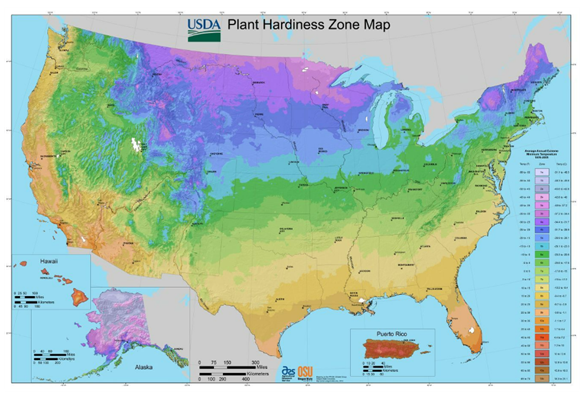
Even within similar climates and hardiness zones, make sure the plants you select are suited to local soil conditions such as acidity level and drainage. Some areas may have similar climates but different soils. For example, Houston, Texas, and Orlando, Florida, are both in hot-humid areas and in hardiness zone 9 but Orlando has sandy soils with good drainage whereas Houston has more clay in its soils and slower drainage. Some plants will be better suited for one site than the other.
Wildfire Prone Areas
In wildfire-prone areas, local municipalities may require that burnable vegetation should be kept to a minimum around the home. In general, there should be no burnable vegetation within 5 feet of the structure, limited trimmed trees and vegetation within 30 feet of the home, and well-spaced trimmed trees and vegetation within 100 feet of the home. For detailed guidance on establishing defensible space around a home located in the wildland-urban interface, see the guide Defensible Space for Protection Against Wildfires.
Training
Compliance
Compliance
Environmental Protection Agency (EPA) WaterSense® Home Specification
Local Jurisdiction
Check with the local jurisdiction having authority in your area for local codes, ordinances, or statutes regarding landscaping, plant selection, irrigation, water catchment, solar access, and/or setbacks.
More
More Info.
Access to some references may require purchase from the publisher. While we continually update our database, links may have changed since posting. Please contact our webmaster if you find broken links.
The following authors and organizations contributed to the content in this Guide.

